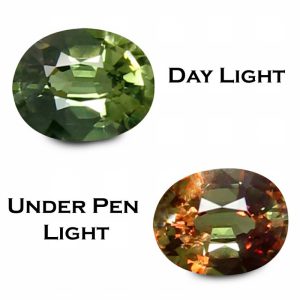
Emerald by day, ruby by night, alexandrite is well known for displaying one of the most remarkable color changes in the gem world — green in sunlight and red in incandescent light. However, the modern June birthstone is so rare and expensive few people have seen a natural alexandrite. This variety of gem-quality chrysoberyl makes an excellent jewelry stone.
Alexandrites have two primary value drivers. First, the closer the colors to pure green and red, the higher the value. Second, the more distinct the color change, the higher the value. Alexandrites can exhibit everything from 100% to just 5% color change. Thus, the most valuable gems would have a 100% color shift from pure green to pure red. Blue-greens and purplish or brownish reds hold less value.
Clarity also plays a significant role in grading. As is the case with a majority of gems, most naturally occurring alexandrite isn’t clean, facetable material. Most is best suited for cabbing. However, an alexandrite’s color change has more effect on its value than its clarity. For example, take two alexandrites of equal size. One gem is eye clean, with a 50% greenish blue to brownish red color change. The other is an opaque cabochon with a 100% green to red color change. The opaque cab would be considered more valuable.
CARING FOR YOUR CHRYSOBERYL GEMS
With a hardness of 8.5, alexandrite makes a very durable stone suitable for any jewelry setting. Nevertheless, take care when faceting the stone. Alexandrite is still sensitive to knocks and extreme heat.
These gems have no special care requirements. You can clean them mechanically, per the instructions of the system used. Of course, you can also wash them with warm, soapy water and a brush. Consult our gemstone jewelry cleaning guide for more information.
